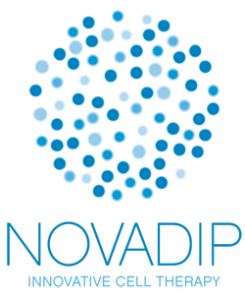Belgian researcher Denis Dufrane and his team of researchers from the University of St. Luc’s (UCL) Cell and Tissue Therapy Center (CTTC) have developed a revolutionary technique that consists of producing a three-dimensional “modeling-clay-like” osseous structure derived from a patient’s own fatty tissue. This first-of-its-kind technology involves a technique in which stem cells are drawn from fatty tissue, cultured and multiplied over the course of two months. The coin-sized structures are then re-implanted into the patient where bone is missing or not capable of being made naturally.

In May 2013 UCL spin-off Novadip Bioscience was created to develop and bring to the market this innovative therapy to a wide spectrum of patients. Developed for patients for whom a solution was no longer available, including children with bone cancer, this technique, which produces a kind of “modeling clay” that can be modeled to fill the empty cavity, will be extended to a range of patients who have difficulty “making bone”.
“This spin-off will allow for the implementation to produce this famous “modeling clay”; pass into the clinical phases and one day be able to offer it to a greater number of patients “, delights Dufrane.
Because it literally creates bone
Baptized Creost®, because it literally creates bone, the researchers from the CTTC began their works with a phase of basic research from 2008 until 2010. The team verified that these cells could be developed under sterile “white room” conditions, (an environment where temperature, humidity and pressure are controlled so as to prevent any contamination). “The objective, or the initial idea was to try using the fat of the patient (taken without pain under local anesthetic), to isolate the fat stem cells, to differentiate them from the osseous cells and return them to the patient, after having obtained a three-dimensional structure susceptible to bone reconstruction”, describes Prof. Denis Dufrane.
From fatty tissue to “flexible” bone matrix (play slide show)
To begin with, a small amount of fat is extracted from the abdomen (under local anesthetic). Once harvested, the fat stem cells are put in culture and differentiated at the CTTC under sterile “white room ” conditions. In as little as two months the fat cell is transformed into an osseous three-dimensional structure resembling a flexible “modeling-clay-like” matrix roughly 2-3 mm thick, without any restriction in terms of volume. This autologous “flexible” bone, containing all the properties of a native bone, is then implanted into the patient.
Why fat is better than bone marrow
For years the most common techniques of regenerative medicine has focused on “stem cells derived from the bone but results for making bone have been disappointing”, explains Prof Dufrane. The team of researchers therefore decided to evaluate all kinds of stem cells and found that “fat contained 500 times more stem cells than bone marrow. They could also differentiate into bone and were completely resistant to deprivation of oxygen and blood vessels.” In the adult there are two essential origins for stem cells: bone marrow, historically, and over the past decade, fat. “The big difference between these two sites lies within the invasive method of extracting the cell. Bone marrow extraction turns out to be very invasive because the cells need to be retrieved from the iliac crest (or hip), an intervention that frequently results in chronic pain. On the contrary, fat cell extraction involves a very simple procedure, which can be performed under local anesthetic. It is not an invasive procedure and it is not a second surgery, which is extremely important.” continues Dufrane.
From research to spin-off
The researchers conducted prolonged animal tests on pigs that had developed fibrosis bone too fragile to sustain pressure and that could no longer be repaired naturally. Results showed that this innovative matrix, once implanted into the “crater-like” cavity of the bone, created a sort of bridge helping to replace what nature could not.
Based on the success of these results, to date, the team at UCL has treated 11 patients, 8 of them children, with fractures or bone defects that their bodies could not repair, have successfully managed to redevelop bone within just a few months and return to living a normal life. Three other patients have been treated for intervertebral lumbar disc degeneration whereby the matrix is inserted exactly where the fusion of two vertebrae needs to be supported. Dufrane expresses, “We are very excited because all patients had bone rebuild, without incurring fractures. Their quality of life has definitely improved. Imagine that these patients should undergo repeat fractures, multiple interventions and long periods of hospitalization.”
With a new technique they believe could become a benchmark for treating a range of bone disorders, Novadip initially seeks to commercialize the treatment to allow spinal fusion among elderly people with degenerated discs. Furthermore, the team from UCL and Novadip Biosciences hope to provide innovative treatments for severe bone healing disorders and bone defects. The spin-off may also seek to create a bone tissue bank using fat cells from donors rather than the patients themselves.
For UCL and Novadip, looks like this revolutionary technique may become one big “fat” success!

Sources:
http://www.lalibre.be/actu/sciences-sante/
http://www.lesoir.be/397621/article/actualite/sciences-et-sante/2014-01-09
http://www.reuters.com/article/slideshow/idUSBREA0E10R20140115#a=2
Contact:
Novadip Biosciences
Chemin du Cyclotron 6
1348 Louvain-La-Neuve
Belgium
Tel:
JF Pollet (CEO)























